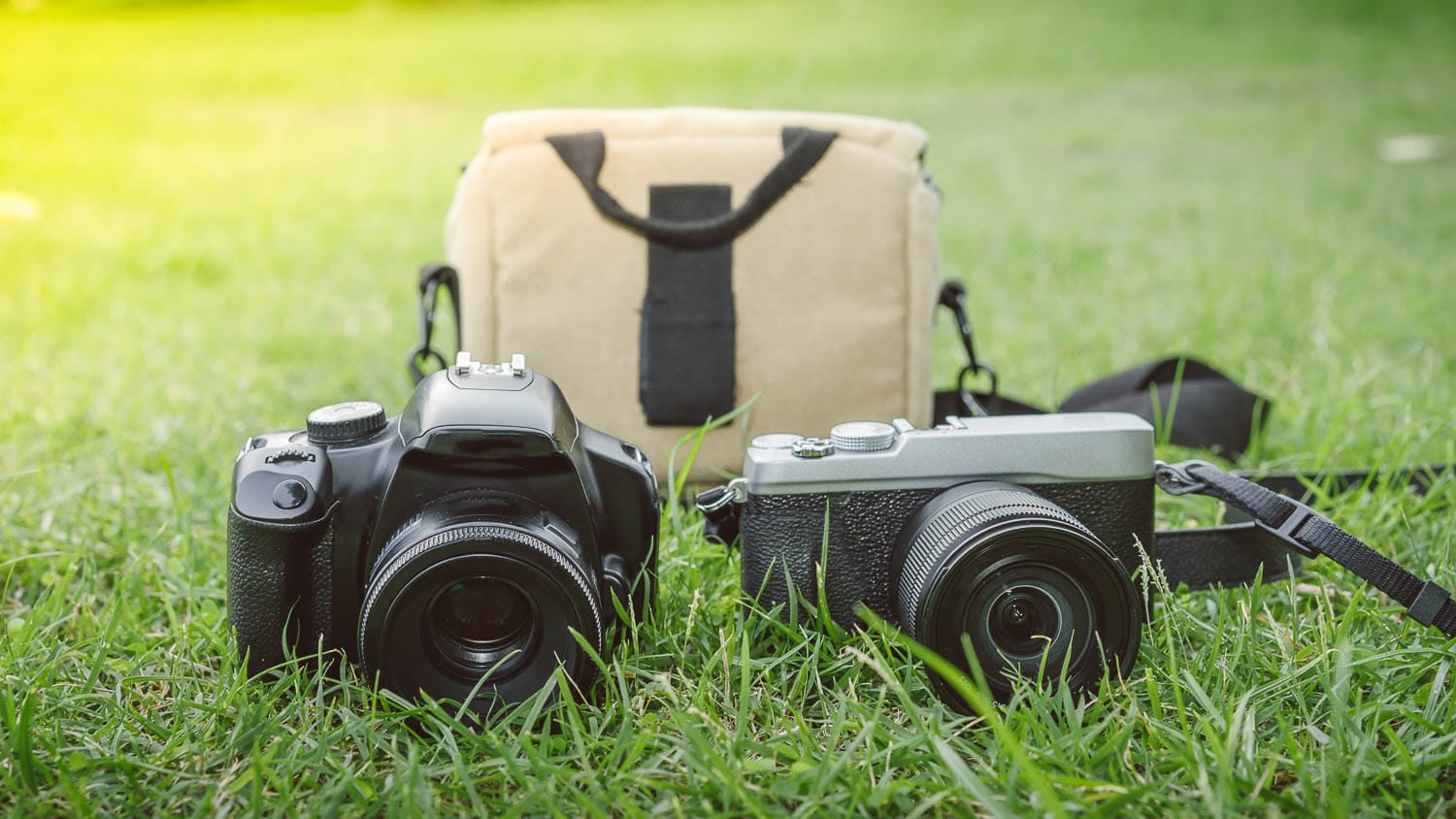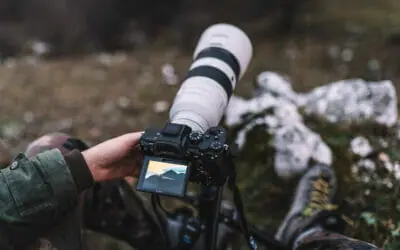Contents
- Differences in how they operate
- Autofocus
- Low-Light Shooting
- Continuous Shooting and Speed
- Imaging Sensor
- Image Stabilization
- Shooting Video
- Viewfinder
- Size and Weight
- Battery Life
- Lens Flexbility
- Cost
- Care
- Overall Performance
- Which is best for you
- How to change systems
- Future of mirrorless vs DSLR cameras
Read Time: 12 minutes
Debate in the photography world over which is better – DSLR vs. mirrorless – has gone back and forth since mirrorless systems entered the picture (pun definitely intended).
Though we may have our personal preference, we're not here to promote one over the other, but to help you decide which is best for you.
While the image quality between the two is comparable, the differences lie primarily in the mechanics of how the shot is taken, which then impacts other aspects of the camera operation and design.
It's tough to definitively say one is better than the other when, quite honestly, that depends on what you're shooting and the conditions you're shooting in.
With that said, let's get into it!
Contents
- Differences in how they operate
- Autofocus
- Low-Light Shooting
- Continuous Shooting Capabilities and Shooting Speed
- Imaging Sensor
- Image Stabilization
- Shooting Video
- Viewfinder
- Size and Weight
- Battery Life
- Lens Flexbility
- Cost
- Care
- Overall Performance
- Which camera type is best for you
- How to change systems
- Future of mirrorless vs DSLR cameras
DSLR vs mirrorless camera: differences in how they operate
The main difference between a DSLR and a mirrorless camera lies in the mechanism they use to capture light: a DSLR uses a mirror to reflect light onto the image sensor, while a mirrorless camera lets light directly hit the sensor, resulting in a quieter and quicker process.
Let's dig a little deeper.
A DSLR (short for Digital Single Lens Reflex) camera operates through a series of steps, from light traveling through the camera’s lens to a mirror that sends the image to the image sensor.
When you press the shutter button to take a photograph, the reflex mirror flips up, obstructing the viewfinder and allowing light to hit the image sensor.
This light is converted into an electric signal that is processed to create the final image. The mirror then flips back into place once the image is captured.
This mechanical procedure is responsible for a DSLR camera's distinctive shutter sound.
On the other hand, a mirrorless camera does away with the mirror mechanism of a DSLR.
Instead, light passes directly through the lens onto the image sensor, which sends a preview of the image to the rear screen or an electronic viewfinder (EVF).
When you press the shutter button, the image sensor records the light information to produce the final photograph.
With no mirror to flip up and down, the mirrorless camera process is quieter and quicker.
While mirrorless cameras might be “quieter and quicker,” the differences don't end there.
Let's take a look at the key differences between these two digital cameras:
Photo: Fabien TWB/Shutterstock
Autofocus
The autofocus system in your average DSLR cameras uses phase detection technology. This is achieved via a separate autofocus sensor that works together with the mirror mechanism to quickly measure the convergence of two light beams.
This method is highly effective in good lighting conditions, but it can struggle in low light or when capturing high-contrast scenes.
On the other hand, most mirrorless cameras use contrast-detection autofocus systems.
Mirrorless camera systems work by maximizing the contrast in the pixel on the sensor itself until it reaches peak sharpness. Contrast detection can be more accurate than phase detection; not suffering from “back focus” or “front focus”. However, it tends to be slower and can struggle with tracking moving subjects.
That said, many of the latest mirrorless cameras now incorporate hybrid autofocus systems, utilizing both phase and contrast detection, significantly improving their autofocus performance and speed.
🏆 Mirrorless vs. DSLR winner: Mirrorless camera with a hybrid autofocus system
Low-Light Shooting
Along with their innovative AF systems, many mirrorless cameras are ideal for shooting in low-light conditions as the electronic viewfinders allow us to see the preview with the adjusted exposure in real-time, thus shortening the need for editing in post-processing.
In contrast, with DSLR cameras you have to tweak everything when shooting in dim setting, while mirrorless cameras do this automatically since they can instantly detect that the environment is poorly lit.
🏆 Mirrorless vs DSLR winner: Mirrorless cameras
Continuous Shooting Capabilities and Shooting Speed
When it comes to capturing action or shooting in burst mode, DSLR and mirrorless cameras offer continuous shooting capabilities, but the speed and performance can vary.
Due to their mirror mechanism, DSLR models have a physical limitation on how fast they can shoot continuously.
When the mirror lifts to expose the sensor, it has to come back down after each shot, which takes time, making the speed of continuous shooting in DSLR equivalents generally slower than in mirrorless cameras.
The highest-performing DSLR cameras can usually shoot up to 10-12 frames per second (fps), while many high-end mirrorless cameras can shoot up to 20 fps in full resolution, and often even faster in lower resolution modes.
However, continuous shooting speed doesn't just depend on the camera alone. It also heavily depends on the capabilities of your memory card.
No matter how fast your camera can shoot, if your memory card can't write the data as fast, you'll find the camera buffer filling up quickly and slowing down.
🏆 Mirrorless vs DSLR winner: Mirrorless cameras
Photo: Alex Yeung/Shutterstock
Imaging Sensor
Unlike DSLR cameras, the camera sensor (or digital sensor) on mirrorless cameras is completely exposed, making it much more prone to damage and dust.
On top of that, since the image is being digitally processed, encountering lag shouldn't be that surprising. The same also applies to lag in refresh rates, but higher-end mirrorless cameras, like the Sony A1's, are exempt. In fact, we are rather impressed with the refresh rate of the A1s – a whopping 240 fps!
🏆 Mirrorless vs DSLR winner: DSLR cameras
Image Stabilization
Image stabilization is a crucial aspect that photographers consider when choosing between DSLRs and mirrorless cameras.
Traditionally, DSLR cameras have relied on lens-based image stabilization, where gyroscopes in the lens detect vibrations and move certain elements to counteract the shake.
However, the newer mirrorless cameras have made significant strides in this area, with many models now offering in-body image stabilization (IBIS).
IBIS works by moving the sensor itself to offset camera shake, a method that can be more effective because it works with any lens attached to the camera.
Therefore, mirrorless cameras tend to have the edge in image stabilization, providing smoother and steadier images, especially in low light conditions or with longer lenses.
🏆 Mirrorless vs DSLR winner: Mirrorless cameras
Photo: Aleksey Boyko/Shutterstock
Shooting Video
When it comes to shooting video, DSLR and mirrorless cameras each offer excellent quality, but with some notable differences.
DSLR technology allows them to shoot high-quality video, but they tend to lack the versatility of their mirrorless counterparts. This is primarily due to the mirror mechanism in a DSLR which can constrain live view autofocus when recording video, often resulting in slower and less reliable autofocus during video recording.
On the other hand, Mirrorless cameras excel in this area due to their lack of a mirror mechanism. They offer continuous autofocus in live view and video modes, which allows for seamless focus transitions and tracking of moving subjects.
Additionally, mirrorless cameras often offer more video features, such as 4K or 8K video, higher frame rates, and log profiles for advanced color grading.
The real-time exposure preview in the electronic viewfinder is also a significant advantage, as it accurately depicts the video's look before recording begins.
🏆 Mirrorless vs DSLR winner: Mirrorless cameras, for their advanced video features and superior autofocus in video mode.
Viewfinder
DSLR cameras utilize an optical viewfinder that works through a process involving a mirror and a pentaprism.
When light enters the lens, it hits a mirror which redirects it up into the pentaprism, which then flips the image and projects it into the viewfinder.
The image seen through an optical viewfinder is a real-time, through-the-lens (TTL) view of what the camera will capture. This allows for a highly accurate and sharp preview, unaffected by lag or pixel resolution.
Mirrorless cameras, in contrast, use electronic viewfinders (EVF). In the absence of a mirror, light from the lens goes directly onto the image sensor, which then transmits a digital image to the viewfinder.
The EVF displays a digital replica of the scene that includes real-time exposure adjustments and additional shooting information.
While this can be incredibly useful for framing and exposure control, the digital rendering can be subject to lag, lower resolution, and a less natural look compared to an optical viewfinder.
DSLR cameras provide a more accurate and natural viewing experience through optical viewfinders, while mirrorless cameras offer a more informative and adaptable one. The choice between the two often comes down to a photographer's personal preference.
🏆 Mirrorless vs. DSLR winner: We're going with DSLR cameras on this one
Photo: Yekatseryna Netuk/Shutterstock
Size and Weight
The physical size and weight of DSLRs and mirrorless cameras can differ significantly.
Mirrorless cameras with their direct light path, are generally smaller, lighter, and easier to carry than DSLRs. Most DSLRs, with their prism and mirror system, tend to be bulkier and heavier.
At the same time, they also typically have a larger grip than mirrorless cameras, which while that adds to its weight, it can also make it more comfortable when shooting for extended periods.
Additionally, that extra size allows for additional battery power (we'll touch on this more below).
Apart from providing long-lasting battery life, DSLR systems can be manipulated more efficiently, and there are many more options to choose from compared to the mirrorless counterpart. Plus, the heavier design also prevents camera shake.
On a sort of related note, mirrorless cameras are also quieter – we all know the mechanical shutter sound of DSLR cameras, and though it may be addicting to some, others find it irritating or disruptive.
🏆 Mirrorless vs. DSLR winner: It completely depends on you, your preferences and how you're shooting!
Photo: Eva Mont/Shutterstock
Battery Life
DSLR cameras typically boast longer battery life than mirrorless cameras as their larger size allows for larger batteries.
Plus, the optical viewfinder in a DSLR camera consumes far less power compared to the electronic viewfinder or rear screen of a mirrorless camera, which has to be constantly powered for live view.
That being said, advancements in battery technology and power management are gradually reducing this gap in newer models.
Some mirrorless models offer a battery grip option for additional power. Of course, that changes size, weight, and cost of the camera. But, it can be an option.
It's worth noting that carrying extra batteries can easily offset this disadvantage, but it's so nice to pop in one battery and know it'll last for a shoot.
🏆 Mirrorless vs. DSLR winner: The DSLR camera, at least for now
Lens Flexibility
DSLR lenses, being part of a mature system with a long history, have a vast selection available from lens designers covering almost all types of photography from macro to wildlife. They tend to be better optimized for their respective camera bodies, offering superior autofocus performance and image quality.
Moreover, third-party lenses for DSLR systems provide a wider range of options suitable for various budgets.
However, the downside is that DSLR lenses are generally larger and heavier due to the need for a longer flange distance.
The mirrorless camera lens mount is simplified, with mirrorless lenses taking advantage of the shorter flange distance in mirrorless cameras.
This makes mirrorless camera lenses more compact and lightweight, making the whole system easier to carry around.
This also enables better edge-to-edge sharpness due to the shorter distance between the lens and the sensor.
As mirrorless systems are newer, the selection of native mirrorless lenses can be limited compared to DSLRs, particularly for less common types of photography.
However, this is rapidly changing as manufacturers expand their lens lineups and third-party lens makers start to support mirrorless mounts more.
🏆 Mirrorless vs. DSLR winner: It's a draw. The choice depends on the specific needs and preferences of the photographer.
Recommended: Whether you're shooting with mirrorless or DSLRs, you need a quality lens to get the best images. Check out our gear guides on the best lenses for wildlife photography, for bird photography, and for landscape photography.
Photo: Alen thien/Shutterstock
Cost
When it comes to cost, both mirrorless and DSLR cameras have options spanning a wide price range, from entry-level to professional-grade models.
However, on average, mirrorless cameras tend to be slightly more expensive than their DSLR counterparts.
This is largely due to the newer technologies incorporated in mirrorless cameras, such as advanced electronic viewfinders, in-camera image stabilization, and high-speed silent shooting capabilities.
DSLR cameras, on the other hand, being a more mature technology, often offer similar image quality at a lower price.
That said, the total cost can also heavily depend on the lenses and accessories you purchase along with the camera body.
🏆 Mirrorless vs. DSLR winner: When it comes to comparing DSLR vs. mirrorless camera cost, it's a toss-up.
Recommended: Curious about pricing and options for both mirrorless and DSLRs? Check out our gear guides on the best camera bodies for wildlife photography, for bird photography, and for landscape photography.
Photo: Yury Nikolaev/Shutterstock
Care
Taking care of any type of camera involves regular cleaning and maintenance, but DSLR cameras can be particularly difficult to clean, especially when dust gets into the sensor.
Although the mirror protects the image sensor from outside exposure, we cannot stress enough how difficult they are to clean, especially if dust comes in.
On top of that, since manufacturers choose not to make them anymore, finding an essential part after it's damaged is an epic challenge.
On the other hand, while mirrorless cameras tend to be easier to clean due to the absence of the mirror mechanism, their electronic components can be more prone to dust and moisture damage than their DSLR counterpart.
The sensor in a mirrorless camera is exposed as soon as you remove the lens, making it potentially more susceptible to dust and dirt.
However, many mirrorless cameras come with automatic sensor cleaning functions and generally have more straightforward maintenance procedures.
Therefore, the care required for each type of camera depends on the specific model and the conditions in which it is used. Regular cleaning, proper storage, and the use of appropriate accessories such as camera bags and lens protectors can help keep your camera in good condition.
🏆 Mirrorless vs. DSLR winner: Your personal comfort level with maintenance procedures and the shooting environments you frequent will dictate which is best for you.
Overall Performance
When it comes to performance, both DSLR and mirrorless cameras have their unique strengths.
DSLRs have been around longer, benefitting from years of design refinement. They offer superior autofocus systems, especially in low-light conditions. The viewfinder allows for real-time composition and a more natural look, with no lag or pixelation.
On the other hand, mirrorless cameras are catching up fast.
Their fewer moving parts make them more silent and less prone to mechanical issues. The electronic viewfinder (even if not as true as those on a DSLR camera) provides a preview of the image as it will appear in the final shot, including exposure, depth of field, and color balance adjustments.
All of that combined with their faster continuous shooting speeds and improvements in autofocus performance, for many photographers, there's no contest at all.
Major camera manufacturers have taken everything that was lacking from DSLR cameras, improved it, and placed it nicely in a compact design. Additionally, perks like a touch LCD screen, OLED electronic viewfinder, and Wi-Fi have made mirrorless cameras that much more attractive.
As companies continue to focus their efforts on improving mirrorless technology, the gap is likely to grow as mirrorless cameras will be updated and improved continuously by major camera manufacturers.
Photo: Ionut Musca/Shutterstock
Which camera type is best for you: DSLR vs. mirrorless camera?
Do we have a verdict of the DSLR vs. mirrorless debate? Ultimately, the best choice for you depends on your needs and preferences. Like we said in the beginning, image quality between the two is comparable.
If you're a beginner, maybe consider a DSLR camera that has the flexibility to play around with the camera settings.
Or, maybe you want to go all-in and explore all the mirrorless technology available, and are curious to try your hand with entry-level mirrorless cameras.
If you're a professional photographer, you may be interested in exploring the mirrorless world (that silent electronic shutter is a dream come true for your wildlife photography!) but already have a DSLR and a full quiver of lenses.
Though mirrorless models look appealing, the idea of switching to a brand-new system feels like a big undertaking and you're not sure if it's the right move.
We wish we could give you a clear winner, but it's just too dependent on you! You as your very own photographer with your very own preferences and style.
How to change from a DSLR system to a mirrorless system
Making a shift from a DSLR system to a mirrorless one doesn't necessarily mean you have to abandon your existing collection of lenses.
One of the most cost-effective ways to switch systems is to purchase a mirrorless camera that is compatible with your existing DSLR lenses. This way, you can continue using your existing lenses while getting accustomed to the new camera system.
Adapters, or lens mounts, can be a game-changer here, allowing you to use your DSLR lenses with your new mirrorless camera body.
These adapters are specifically designed to preserve the connection between the lens and the camera while adjusting for the shorter flange distance in mirrorless systems.
It's important to keep in mind, however, that not all lens functions may be preserved when using an adapter. For instance, the effectiveness of autofocus and image stabilization may be reduced.
So, while lens mounts can save you the cost of purchasing new lenses, they may not always provide the full functionality you would get with native mirrorless lenses.
Remember that switching doesn't need to be done all at once – you can gradually transition and add to your mirrorless system as you become more comfortable with it and more certain of your specific needs.
Photo: MMD Creative/Shutterstock
Future of mirrorless vs DSLR cameras
The debate between DSLR and mirrorless cameras is one that continues to evolve. As of now, mirrorless technology is advancing at an unprecedented rate, with manufacturers investing heavily in the development of new features and capabilities.
In the ever-evolving realm of photography, it's clear that mirrorless cameras are poised to redefine the future landscape. Given the rapid advancements in mirrorless technology, along with the benefits of compactness, silent operation, and the real-time preview of images, it's only a matter of time before they potentially eclipse DSLR cameras.
This is not to say that DSLRs will be obsolete right away, as they still hold a firm place in the market due to their superior autofocus systems and natural viewfinder experience.
That said, the day will likely come when mirrorless cameras become the new standard in photography, replacing DSLRs.
For right now, however, the choice between a DSLR and a mirrorless camera should be dictated by your specific needs, preferences, and comfort level with the differing technology and maintenance requirements.
Ultimately, your passion for photography and your personal preferences will guide your choice today, but keep an eye on the horizon for the exciting changes that the future holds.























